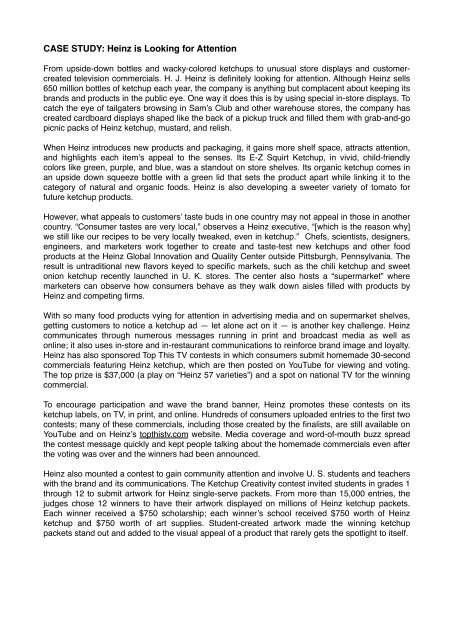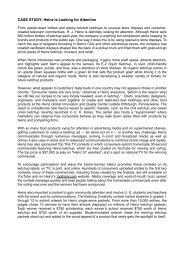Case Study - Heinz
Create successful ePaper yourself
Turn your PDF publications into a flip-book with our unique Google optimized e-Paper software.
CASE STUDY: <strong>Heinz</strong> is Looking for Attention<br />
From upside-down bottles and wacky-colored ketchups to unusual store displays and customercreated<br />
television commercials. H. J. <strong>Heinz</strong> is definitely looking for attention. Although <strong>Heinz</strong> sells<br />
650 million bottles of ketchup each year, the company is anything but complacent about keeping its<br />
brands and products in the public eye. One way it does this is by using special in-store displays. To<br />
catch the eye of tailgaters browsing in Sam’s Club and other warehouse stores, the company has<br />
created cardboard displays shaped like the back of a pickup truck and filled them with grab-and-go<br />
picnic packs of <strong>Heinz</strong> ketchup, mustard, and relish.<br />
When <strong>Heinz</strong> introduces new products and packaging, it gains more shelf space, attracts attention,<br />
and highlights each item’s appeal to the senses. Its E-Z Squirt Ketchup, in vivid, child-friendly<br />
colors like green, purple, and blue, was a standout on store shelves. Its organic ketchup comes in<br />
an upside down squeeze bottle with a green lid that sets the product apart while linking it to the<br />
category of natural and organic foods. <strong>Heinz</strong> is also developing a sweeter variety of tomato for<br />
future ketchup products.<br />
However, what appeals to customers’ taste buds in one country may not appeal in those in another<br />
country. “Consumer tastes are very local,” observes a <strong>Heinz</strong> executive, “[which is the reason why]<br />
we still like our recipes to be very locally tweaked, even in ketchup.” Chefs, scientists, designers,<br />
engineers, and marketers work together to create and taste-test new ketchups and other food<br />
products at the <strong>Heinz</strong> Global Innovation and Quality Center outside Pittsburgh, Pennsylvania. The<br />
result is untraditional new flavors keyed to specific markets, such as the chili ketchup and sweet<br />
onion ketchup recently launched in U. K. stores. The center also hosts a “supermarket” where<br />
marketers can observe how consumers behave as they walk down aisles filled with products by<br />
<strong>Heinz</strong> and competing firms.<br />
With so many food products vying for attention in advertising media and on supermarket shelves,<br />
getting customers to notice a ketchup ad — let alone act on it — is another key challenge. <strong>Heinz</strong><br />
communicates through numerous messages running in print and broadcast media as well as<br />
online; it also uses in-store and in-restaurant communications to reinforce brand image and loyalty.<br />
<strong>Heinz</strong> has also sponsored Top This TV contests in which consumers submit homemade 30-second<br />
commercials featuring <strong>Heinz</strong> ketchup, which are then posted on YouTube for viewing and voting.<br />
The top prize is $37,000 (a play on “<strong>Heinz</strong> 57 varieties”) and a spot on national TV for the winning<br />
commercial.<br />
To encourage participation and wave the brand banner, <strong>Heinz</strong> promotes these contests on its<br />
ketchup labels, on TV, in print, and online. Hundreds of consumers uploaded entries to the first two<br />
contests; many of these commercials, including those created by the finalists, are still available on<br />
YouTube and on <strong>Heinz</strong>’s topthistv.com website. Media coverage and word-of-mouth buzz spread<br />
the contest message quickly and kept people talking about the homemade commercials even after<br />
the voting was over and the winners had been announced.<br />
<strong>Heinz</strong> also mounted a contest to gain community attention and involve U. S. students and teachers<br />
with the brand and its communications. The Ketchup Creativity contest invited students in grades 1<br />
through 12 to submit artwork for <strong>Heinz</strong> single-serve packets. From more than 15,000 entries, the<br />
judges chose 12 winners to have their artwork displayed on millions of <strong>Heinz</strong> ketchup packets.<br />
Each winner received a $750 scholarship; each winner’s school received $750 worth of <strong>Heinz</strong><br />
ketchup and $750 worth of art supplies. Student-created artwork made the winning ketchup<br />
packets stand out and added to the visual appeal of a product that rarely gets the spotlight to itself.
<strong>Case</strong> Questions:<br />
1. Using the concepts discussed in Chapter 3, explain how <strong>Heinz</strong> has been successful in<br />
generating exposure and capturing attention. What other ideas would you suggest <strong>Heinz</strong> try to<br />
foster exposure, attention, and perception?<br />
2. In terms of exposure, attention, and perception, what are some of the potential<br />
disadvantages of <strong>Heinz</strong>’s Top This TV contest?<br />
3. Do you think that <strong>Heinz</strong> will gain long-term benefits from holding a contest for students that<br />
focused on the visual appeal of designing single-serve ketchup packets? Explain your answer.



